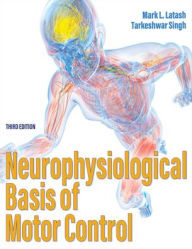Neurophysiological Basis of Motor Control by Mark L. Latash, Tarkeshwar Singh on Ipad
Neurophysiological Basis of Motor Control by Mark L. Latash, Tarkeshwar Singh


- Neurophysiological Basis of Motor Control
- Mark L. Latash, Tarkeshwar Singh
- Page: 464
- Format: pdf, ePub, mobi, fb2
- ISBN: 9781718209527
- Publisher: Human Kinetics Publishers
Download free account book Neurophysiological Basis of Motor Control by Mark L. Latash, Tarkeshwar Singh in English 9781718209527 PDF
The study of motor control is evolving into a field of natural science comparable in its rigor and exactness to established fields such as classical physics. This advancement necessitates a resource that offers more precise terminology and rigorous logics. Neurophysiological Basis of Motor Control, Third Edition, rises to the challenge by building on its foundation with thoroughly updated information, expanded content, and an organizational overhaul. By emphasizing the neurophysiological mechanisms involved in the processes of generating voluntary movements, the text offers a distinct understanding of how the brain generates control signals and how the body executes them. Author Mark Latash, PhD—founding editor of the journal Motor Control and past president of the International Society of Motor Control (ISMC)—combines his expertise with the experience of new coauthor Tarkeshwar Singh, PhD, director of the Sensorimotor Neuroscience and Learning Laboratory at Penn State University. In the third edition of this book, previously titled Neurophysiological Basis of Movement, the authors present the following: New chapters on motor learning and sensorimotor integration Expanded sections dedicated to the role of different sensory modalities in motor control, kinesthetic perception, and action–perception interactions An exploration of the basis of neuroanatomy, aging and development, motor disorders, and basic concepts such as coordination, reflexes, voluntary movement, sensation, and perception Supported with hundreds of illustrations and chapter introductions that provide smooth transitions from one topic to the next, the third edition also incorporates thought-provoking problems that encourage students to think critically and become aware of the types of motor control issues that have yet to be studied or solved. At the end of each section, additional problems are offered in short essay and multiple-choice formats as a means of self-testing. Other supplemental learning aids include chapter summaries as well as key terms and topics. Neurophysiological Basis of Motor Control, Third Edition, deepens students’ knowledge of the link between the brain and movement with basic facts about neural motor control, neuroanatomy, and movement disorders. The text will help usher in a new era in the study of motor control, promoting independent thinking and sharing thought-provoking ideas on current theories of motor control and coordination.
Neurophysiological correlates of motor planning - BMJ Open
Neural correlates of motor planning will be measured using electroencephalography. In detail, movement-related cortical potentials, frequency spectral power and
The Role of Movement Representation Techniques in - NCBI
However, during MI, the control of movement creation is consciously dependent Decety J. The neurophysiological basis of motor imagery.
Neurophysiological Basis of Motor Control - Den Hertog
Neurophysiological Basis of Motor Control, Third Edition, emphasizes the neurophysiological mechanisms relevant to the processes of generating voluntary
Neurophysiological Basis of Motor Control - Amazon.com
The study of motor control is evolving into a field of natural science comparable in its rigor and exactness to established fields such as classical physics
The neurophysiological basis of motor imagery. - Abstract
by J Decety · 1996 · Cited by 885 — This paper reviews physiological evidence from measurements of regional brain activity and from measurements of autonomic responses in normal subjects and
Neurophysiological evidence of the dynamic and adaptive
of pain and motor processing and their corresponding neurophysiological basis. Understanding how the brain plans and controls movement in the context of
Neurophysiological Foundations and Practical Applications of
Typically, mentally simulating a movement is referred to as motor imagery (MI), which is defined as a dynamic mental state during which the representation of a
Neurophysiological Basis of Movement Hardcover
These worlds are cells, connections, structures, behaviors (control and coordination), evolving and changing behaviors, and motor disorders. The first three
Neurophysiology & motor control - LUNEX University
The Neurophysiology and Motor control research area comprises the following research domains: Neural correlates of sports performance, Effects of sport and
Neurophysiological Basis of Movement - 2nd Edition
These worlds are cells, connections, structures, behaviors (control and coordination), evolving and changing behaviors, and motor disorders. The first three
The neurophysiological basis of motor imagery - PubMed
It is proposed that motor imagery shares neural mechanisms with processes used in motor control. This review emphasizes the importance of the prefrontal cortex
Neuromotor Basis for Motor Control - AccessPhysiotherapy
Concept: The neuromotor system forms the foundation for the control of movement. After completing this chapter you will be able to. Describe the general
Progress in Motor Control: Theories and Translations
Neurophysiological Mechanisms of Motor Control · Front Matter. Pages 141-141 · What Do TMS-Evoked Motor Potentials Tell Us About Motor Learning? Richard G. · Motor
Neurophysiological Basis of Deep Brain Stimulation and
Moreover, since each muscle of the stomatognathic system is controlled by the bilateral cortex through the corticobulbar tract and certain cranial nerves (CNs (
Neuroplasticity subserving motor skill learning - PMC - NCBI
One of the key brain regions involved in fast learning is M1. Consistently, it was shown in humans that learning a motor task modulates LTP-like plasticity (
0コメント